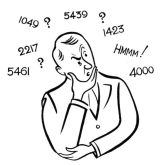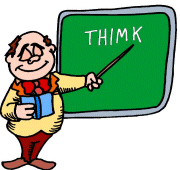 |
Trotter Numbers
&
Trotter Primes |
 |
|

Recently (June 2001) I became aware of an interesting website, dedicated to the discovery and reporting of appearances of the number 47 in our world. It is called, appropriately enough, the
47 Society. They post e-mail notes from the members about any trivia related to what they claim is the "quintessential random number". Well, if you have read the pages of WTM, it should come as no surprise to you that I "enlisted" in the society. And on June 8, I wrote my first e-mail to them, which said:
Hey, I like your neat project about 47. While I'm not quite ready to believe that 47 is the only number worth looking for, :>) , I do enjoy looking for number facts of any kind.
So here's my humble contribution...
About 9 years ago I wrote a letter that was published in the Nov. '92 issue of the MATHEMATICS TEACHER (NCTM) about "1992". You see, 1992 = 8 x 3 x 83. But also in the past thousand years only 2 other years had that same structure: a x b x 'ab'. They were 1533 = 7 x 3 x 73 and (ta-dah!) 1316 = 4 x 7 x 47.
This morning as I lay in bed thinking about "47" (yes, this is true), it struck me that "47" was the concatenation of "4" [a square; I like squares, too] and "7" [the "ubiquitous 7", as I like to say]. So I began examining other such cases.
We get 17, 47, 97, 167, 257, 367, ... all primes so far. [But of course, 497 isn't prime, but that was sorta to be expected.] Some future terms from here on are primes, while others are not.
BUT 47 is the 2nd prime in this sequence, and 2 is the only even prime. So that might count for something, huh?
[Which brings to mind this quote: All primes are odd except 2--which is therefore the oddest of them all. [Knuth] ]
I hope you like this, and I'll keep my eye out for more 47's, okay?
That little comment about the sequence of numbers containing the number 47 was the inspiration of all that follows in this article. I warn you -- it gets wild at times. Enjoy.
Definition
The set of Trotter Numbers is a subset of the natural numbers, or positive integers, defined by the following rule:
T(n) = 10 * n2 + 7, where n = 1, 2, 3,
The sequence begins: 17, 47, 97, 167, 257, 367, 497,
Whenever a given T(n) [aka TN] is prime, it shall be called a Trotter Prime (TP).
After a few moments of close observation and reflection, one should notice that while the first six consecutive TN's given are prime, the 7th one, 497, is a composite number. It is equal to 7 × 71. This characteristic alone, that in the TN sequence -- unlike the sequence of natural numbers -- primes can be consecutive, makes the set of Trotter Numbers interesting.
However, while it is quite easy to expect that among the infinite number of TN's, some will be prime and some will be composite, you still have to test each TN to see if it is also a TP.
Lucky for us: we can easily prove that every 7th one can not be prime. Hence, there can never be a string of TP's longer than 6. The question merely remains: do strings of 5, 4, or 3 TP's exist? If so, where are they? That is what you, as the great prime hunter, must do -- find 'em, and tag 'em!

This is where we stop on this page. Now it's up to you. You must start investigating the topic of Trotter Numbers and Trotter Primes before you turn the page, as it were, to see what patterns or odd tid-bits of trivia you can find, then compare your results with what WTM has discovered so far.
When you finish with your reseach, collect all your notes together, and turn to Page 2. Thank you and good luck!
P.S. WTM is rather pleased to state that the sequence given above can be found in Sloane's On-line Encyclopedia of Integer Sequences and has its own reference number: A061722.



